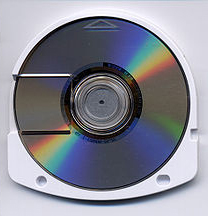Universal Media Disc
The Universal Media Disc (UMD) is an optical disc medium developed by Sony for use on the PlayStation Portable. It can hold up to 1.8 gigabytes of data. It is the first optical disc format to be used for a handheld video game system.

Overview
ECMA-365: Data Interchange on 60 mm Read-Only ODC – Capacity: 1.8 GB (UMD)
- Dimensions: approx. 64 mm (diameter) × 4.2 mm (thickness)
- Maximum capacity: 1.80 GB (dual layer), 900 MB (single-layer)
- Laser wavelength: 660 nm (red laser)
- Encryption: AES 128-bit
DVD region coding has been applied to most UMD movies and music, although no games except BattleZone enforce regional lockout, making them, in effect, region free.
- Region 0: Worldwide
- Region 1: United States, Canada, U.S. territories, Latin America
- Region 2: European Union, Japan, Middle East, Egypt, South Africa, Greenland, French territories
- Region 3: Singapore, Malaysia, Taiwan, South Korea, the Philippines, Indonesia, Hong Kong
- Region 4: Australia, New Zealand, Pacific Islands, Latin America
- Region 5: Russia, Eastern Europe, Pakistan, India, the majority of Africa, North Korea, Mongolia
- Region 6: Mainland China
Applications
The primary application for UMD discs is as a storage medium for PSP games, although the format is also used for the storage of motion pictures, and to a lesser degree, television shows for playback on the PSP. The video is encoded in the H.264/MPEG-4 AVC format, with the audio in ATRAC3plus.
The BBC released a number of its TV titles on UMD in the UK, including The Office, The Mighty Boosh, Doctor Who and Little Britain.
Some adult films have been released on UMD in Japan.
Circumvention
Despite Sony's efforts, the UMD format has been cracked. Using a combination of custom firmware and reverse engineering, the Sony PSP will run a variety of homebrew games, and backup ISO images. Each disc uses a file system whose format follows the ISO 9660 standard. The ISO image can then be stored on a Memory Stick, and run via a special disc image loader program, such as Devhook, or launched in the XMB with a custom firmware.
Criticism
The UMD discs offer large capacity and the capability to store quality audio/video content, however, the format's proprietary nature and the lack of writers and blank media has made adoption difficult. In comparison to Sony's MiniDisc format, there are a number of features lacking; the sliding shield which prevents direct disc contact on MiniDiscs is absent from all UMDs released to date, though it is an option according to the ECMA specification.
The smaller capacity of the UMD discs necessitates that bonus content from DVD releases be removed in large part or entirely before the movie is released on UMD for PSP playback.[citation needed] This has made the UMD movie releases a difficult sell in the face of affordable portable DVD players that can output to TV sets and can play the full-featured DVD releases.
An image of Multimedia Recovery's UMD replacement case.
Provisions
According to the official ECMA specification Sony designed the UMD to support two possible future enhancements and products.
- 1. Protective Shutter: Similar to the MiniDisc and 3½" floppy disc, this protective shutter will shield the inner disc from accidental contact.
- 2. Auto-Loading: UMDs were designed for possible future slot loading devices with Auto-Loading mechanisms. These would be very similar to the auto-loading mechanism used in slot loading MiniDisc home and car decks.
It would also be similar to the VHS U-Matic auto-loading mechanism. Unlike the current clamshell loading design the PSP uses, a slot loading device using an Auto-Loading mechanism would be motorized and completely automatic.
You would insert the disc into the device slot, similar to the way you insert a VHS cassette into a VCR, and a disc into the PS3, and as you begin to insert it, the motorized mechanism would then take over and completely draw the disc inside the drive, and complete the loading process.
The disc would also be ejected fully automatically by the motorized mechanism, like a VCR. This would also mean that power would be required in order to insert or eject a disc.
Availability & support
The UMD format never saw implementation on any device other than the PlayStation Portable. As a result, the market is very limited compared to those for other optical media formats. But, although poor sales early on in the format's life had caused major studios Universal and Paramount to rescind their support, Sony, Columbia, and other film publishers continue to distribute their films on UMD.
In late 2009, Sony began pushing developers away from the UMD format and towards digital distribution on the PlayStation Network in preparation for the launch of the digital-download-only PSP Go, which is the first PSP model to not include a UMD drive.
